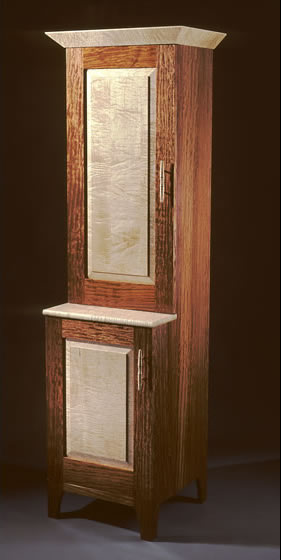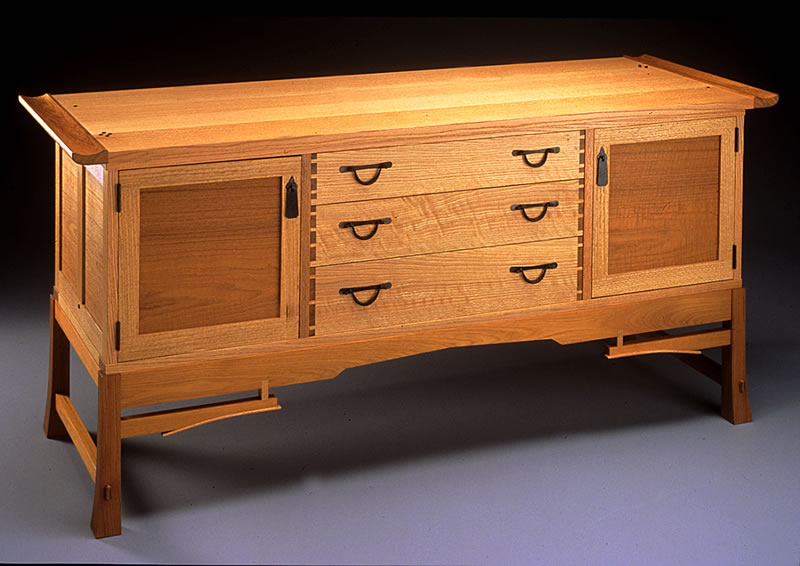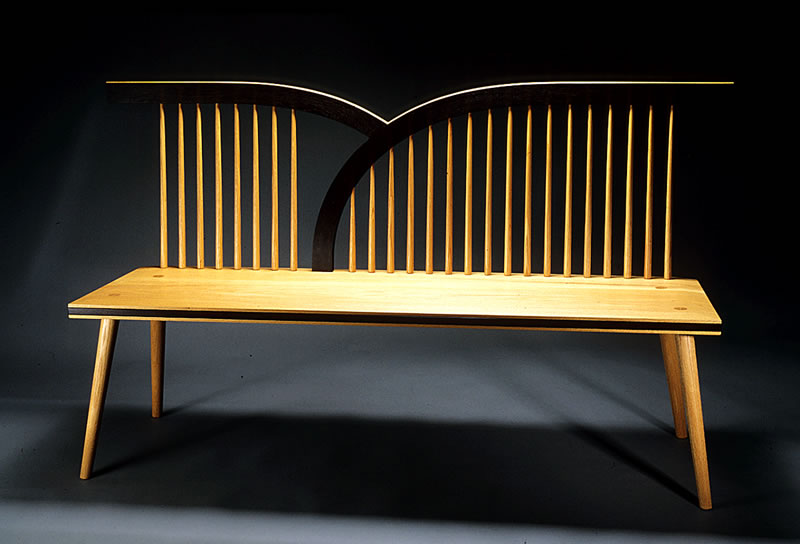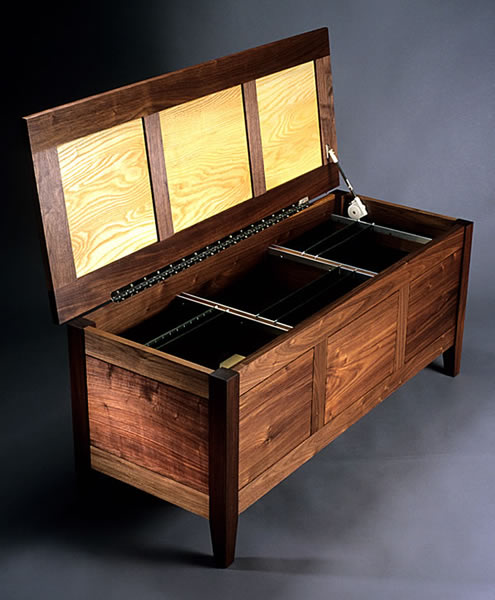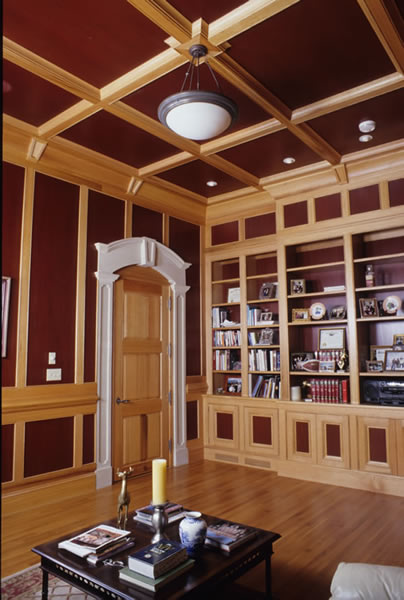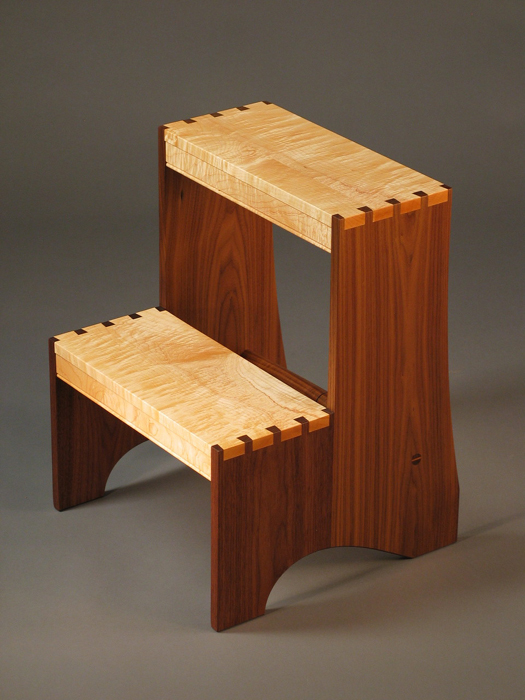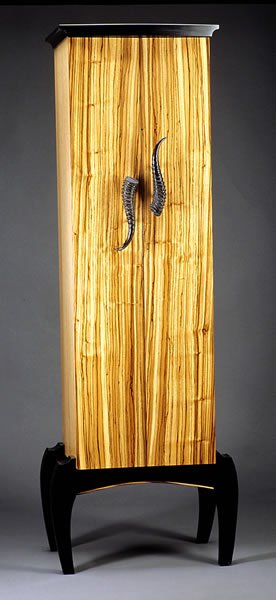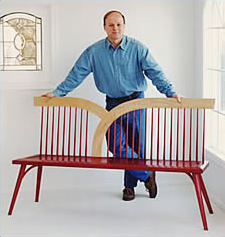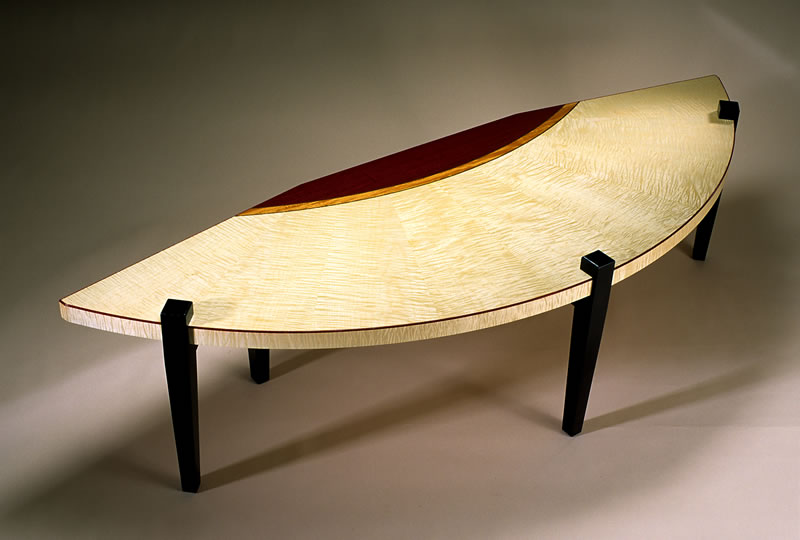
He’s built furniture for the Chief Executive Office of the White House, done work for the World Bank, been exhibited at the Smithsonian Institution, designed and patented a tape measure holder called “The Gripper” and, not surprisingly, won numerous awards for his outstanding woodwork. In short, Dennis Paul Peterson boasts the sort of credential portfolio to which most woodworkers aspire. Along the way he’s managed to craft a design style that spans both years and cultures; one he calls “contemporary classic.”
“Often I will combine Shaker and Asian,” Dennis explained, “to get a classic contemporary look. My contemporary Shaker cupboard is a good example of that, mixing dramatic wood choices with simple lines. Another is a room I did with a traditional coffered ceiling, using two contrasting color woods to make something very traditional in structure look quite modern. That’s the same reason I often use contrasting woods in my furniture. Using two different woods adds a contemporary feel to something comfortably traditional.
“The Hirukan cabinet and Hirukan credenza display a good example of yet another element I like to add. Hirukan (pronounced ‘here you con’) is a Japanese word indicating a curved or worm-like configuration. I try to incorporate at least one curved element on each piece. In the cabinet it shows up as a curved bead, but that same curve can show up in different places. On one table, one of the four legs mimics a plant stem with a curved offshoot coming off the bottom. Other pieces, like a table called Many Voices, incorporate the curves into the basic elements of the piece, such as legs, backs, tops and aprons.
“Brush stroke bench, which also shows Asian influence, is a part of a series of benches I made that also combine styles. The first one is a traditional deacon’s bench with turned legs, hand riven spindles, and a back that mimics the curves used in Japanese brush stroke painting. Others followed, including one done in walnut that I made for my wife for our anniversary.”
While Dennis had early exposure to woodworking, it was not his first career choice. “My first experience with actual woodworking,” he recounted, “was when I was nine or 10. I was in a soapbox derby, and we had to make the whole thing ourselves. My father was a carpenter, so he helped point me in the right direction. At home, we had an old Craftsman cast-iron table saw that I learned how to use a bit, and as I got older I helped him on a couple of jobs, but that was all. I really was not interested in woodworking, and didn’t do much more until I was 27.
“Just before my senior year of high school, I had a motorcycle accident which left me on a brace and crutches for the next two years. I had always been involved in sports, and was determined to get back in shape. Once I could walk again, I got a bicycle and got interested in riding and racing to get back into shape. I studied art and photography in college, but left after three years to open a bicycle shop in 1972. In 1975, I sold the bicycle shop and instead went to work for a friend who ran a cabinet shop. Even though we only did kitchen cabinets, that hooked me on woodworking.
“Three months later, I got a job with a house builder, and continued to do that for almost seven years, sometimes working for others and sometimes on my own. I found that I really liked the detail work involved, and decided to get out of house building and back into a cabinet shop. By 1985, I was doing odd jobs when I got married, moved to Washington D.C., and got a job trimming out houses. Three months later, I landed a job in a prestigious cabinet shop, which is what I wanted all along, and worked there for about three years. There were a hundred journeymen cabinetmakers working there.
“I ran a crew of six running a job for the White House. We also did work for the Smithsonian Institution, the World Bank, and other high-profile buildings. There were people from all over the world working there. It was an incredible learning experience working with that many people from so many areas, and that is where I really cut my teeth on learning how to do things with precision. In 1988, I moved back to Ohio where land is cheaper, opened my own shop, and have been running it ever since.
“While I don’t do multiples, I often duplicate a style, typically as custom orders in different sizes and woods. People are really specific these days, and thanks to that, I have never done two of any piece, except for a simple step stool I make. That is my only production item. It allows me to use up scrap wood and offers customers an entry-level piece they can buy inexpensively. I’ve learned to appreciate a well-executed piece no matter how simple and no matter what style it represents.”
One of the more recent style influences on his work is Africa. “Serengeti is one of my newer pieces,” he explained, “and one that went over very well when we exhibited it at shows. I’ve been interested in going on safari, and though I’ve never been, I decided to design some pieces using African woods. The handles on the Serengeti cabinet are real African springbok horns. Those influences also show up on the Okai table and on a hall table made of zebrawood, oak and ebony which also sports an antelope horn drawer pull.
“I think furniture should be utilitarian,” Dennis insisted, “but that does not mean it can’t be beautiful and have nice lines. There is art in everything, including how you put a piece together and proportion it. Granted, there is more craft than art in furniture. You can be a good craftsman with your head and hands, but it becomes art when you put your heart into it as well.”
I asked him about his patent, noted on his web site but apparently no longer on the market. “Back in 1985, I patented a Velcro® tape measure holder called The Gripper and sold it for years,” Dennis told me, “but eventually stopped when someone copied it with a magnetic version. It allowed you to use a tape measure quickly without the clip ruining your pants.
“Frankly, though,” he admitted, “I’d rather build furniture. I really enjoy it and hope I can do it the rest of my life.”
